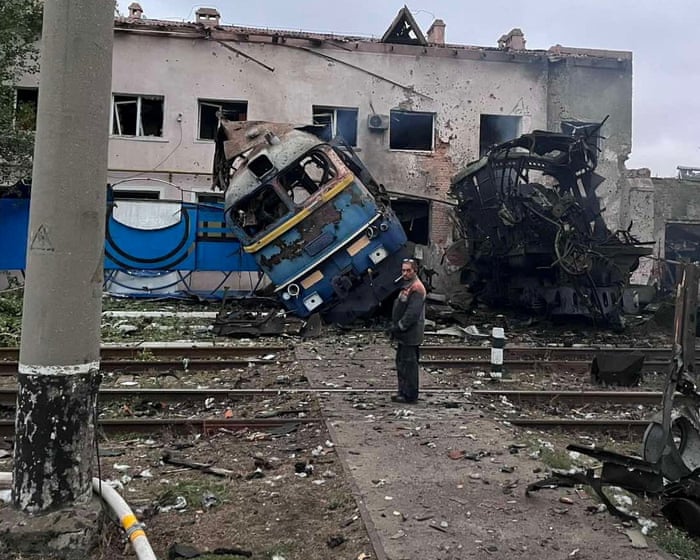Ukraine has seen a threefold rise in attacks on its railway system since July, a senior minister reported, as Moscow attempts to disrupt one of Kyiv’s vital logistical networks.
Oleksii Kuleba, the deputy prime minister overseeing infrastructure, stated that attacks on the railway network since the beginning of 2025 have resulted in $1 billion (£760 million) in damages.
“In the last three months alone, attacks have tripled,” Kuleba said. “Since the start of the year, there have been 800 attacks on railway infrastructure, damaging over 3,000 railway facilities. These escalating attacks are increasingly targeting trains, with a particular focus on killing drivers.”
Railways are crucial in a country as large as Ukraine. According to state statistics, the rail network handles more than 63% of the nation’s freight—including grain shipments—and 37% of passenger traffic. Foreign military aid often arrives by train as well.
With no civilian airports operating since Russia’s full-scale invasion, most people, including visiting world leaders, enter and leave the country by rail.
“It’s not just the number of attacks, but also the tactics of the enemy forces,” said Oleksandr Pertsovskyi, head of Ukrainian state railways, Ukrzaliznytsia. “Now, with their highly accurate Shahed drones, they are targeting individual locomotives.”
Measures to enhance the network’s protection are being implemented, such as equipping trains with electronic systems to counter drone strikes and training railway staff to form dedicated air defense teams.
Earlier this year, the main station building in Lozova, Kharkiv region, was severely damaged in a drone strike. Other attacks have harmed the tracks. Despite these assaults, passengers continue to line up for tickets and board trains to destinations nationwide.
Tetyana Tkachenko, the station manager, recalled a recent nighttime attack: “It was night, and everyone was asleep. I woke up to a huge explosion because I live very close to the station. It happened at 2:44 a.m. There were five trains at the station, including a small suburban train scheduled to depart two hours later. It was clear they were targeting the station. They intended to hit it, and they succeeded.”
Tkachenko showed the damage, pointing out a ruined platform and the main waiting room, both now out of service. The building’s facade is scorched and partially collapsed, with a heap of twisted metal on the unused platform.
She explained why Lozova station was a target: “Lozova is a major junction with routes leading in four directions—to Dnipro, Sloviansk, Poltava, and Kharkiv.”
These rail lines are used for passenger travel, freight, and military support, including evacuating wounded soldiers from the eastern front.Old fishing nets from France are now being used as crucial protection against Russian drones in Ukraine.
“The threat these days is really significant,” Tkachenko stated. “The Russians are attacking directly where people gather, aiming to damage rails and locomotives and destroy high-voltage lines.”
Oleksandr Podvarchansky, responsible for the railway tracks in the Lozova area, explained the procedure when air raid sirens go off. “Our main goal is to protect people’s lives,” he said. “Every time there’s an air alarm, we must stop and take shelter. If a train is on the tracks, we move it to the nearest station so passengers can evacuate.”
Kuleba outlined Russia’s three objectives: disrupting Ukraine’s southern logistics to block goods from reaching seaports, interfering with rail traffic near frontlines in regions like Chernihiv and Sumy, and “destroying everything” in the Donbas, Ukraine’s industrial eastern region that includes Donetsk and Luhansk.
The railway network has also faced bomb threat hoaxes, including one targeting a recent international service. Most officials believe Russia is behind these incidents.
Although tracks can be repaired quickly—often within a day, according to Podvarchansky—damage to trains is a more serious concern.
In a recent interview with the Associated Press, Serhii Beskrestnov, a Ukrainian military and drone expert, noted that trains are especially vulnerable to drones because they move slowly and follow predictable routes.
As Russian drones increase in range and sophistication, more railway sections are becoming potential targets. “If the Russians continue to hit diesel and electric locomotives,” Beskrestnov warned, “we’ll soon reach a point where the tracks are fine, but we have no trains left to run on them.”
Frequently Asked Questions
Of course Here is a list of FAQs about Russias increased attacks on Ukraines railway system with clear and concise answers
Basic Understanding Context
1 Why are railways so important to Ukraine right now
Ukraines railways are the countrys main artery for moving military supplies humanitarian aid and evacuating civilians They are crucial for the entire war effort and for keeping the country connected
2 Why is Russia targeting trains and railway stations
By attacking the railway system Russia aims to disrupt Ukraines military logistics slow down the delivery of Western weapons create chaos for civilians and damage the countrys economy and morale
3 What kind of damage are these attacks causing
Attacks are destroying tracks bridges train stations power lines for electric trains and rolling stock This causes major delays reroutes and sometimes casualties
4 Are passenger trains being targeted or just military ones
While military logistics are the primary target the attacks often hit critical infrastructure used by both military and civilian trains This puts passenger trains and stations at significant risk
Impact Consequences
5 How do these attacks affect civilians
Civilians face disrupted travel difficulty evacuating from conflict zones delays in receiving essential goods and the direct danger of being caught in an attack on a station or train
6 What is the economic impact of damaging the railways
Ukraines economy relies on railways to export grain and other goods to fund its war effort Damaging this system strangles vital revenue and disrupts internal trade and supply chains
7 How is Ukraine responding to protect its railways
Ukraine is actively repairing damaged sections using antiaircraft defenses to protect key junctions dispersing and camouflaging important assets and developing alternative routes
8 Is this a new strategy in the war
While railways have always been a strategic target the frequency and intensity of these attacks have recently increased suggesting a more focused campaign by Russia
Deeper Analysis Technical Aspects
9 What weapons is Russia typically using for these attacks
Russia is using a combination of missiles drones and guided aerial bombs to strike railway targets
10 How resilient is Ukraines railway system
Ukraines railway Ukrzaliznytsia has




